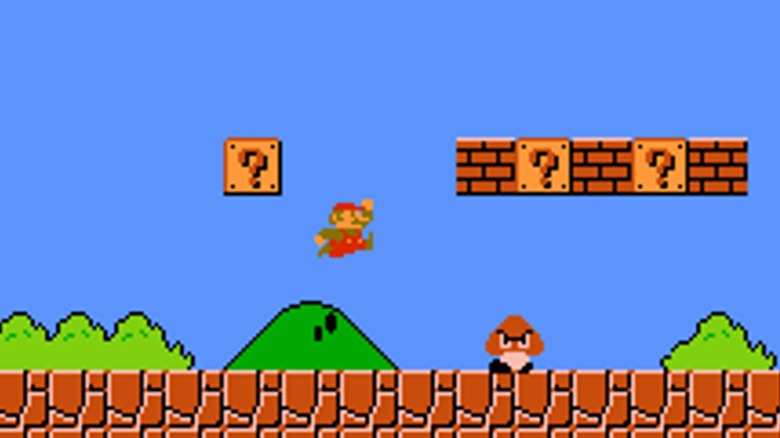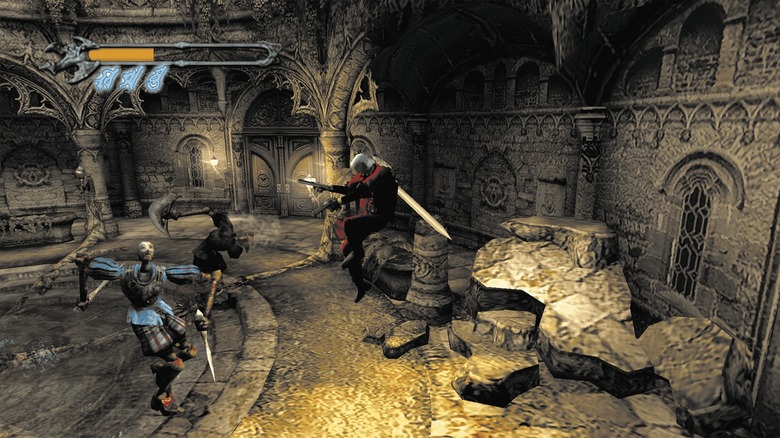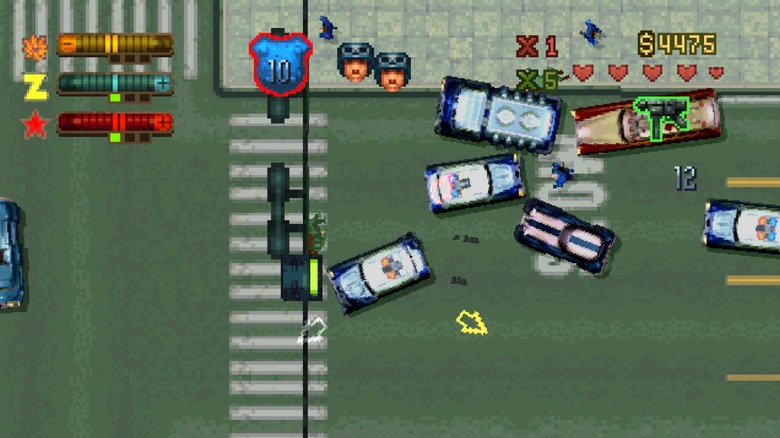Accidents That Made Great Games Even Better
Making a video game is a delicate and complicated process. So many small details need to be juggled in perfect harmony in order for a game to function. Even the most intricately planned AAA games are bound to have a few glitches and bugs that the developers never intended. These glitches can range from game-breaking problems to silly visual gags, and many of them have taken on a life of their own among gamers. Whether it's finding secret glitched levels in the original "Super Mario Bros." or filling a room with infinite dogs in "Skyrim," some games are more fun with their glitches left in them.
Now, what happens when a game designer discovers a glitch during development that's just too much fun to remove? In many cases, the developers add it to the official release. Sometimes a glitch is either too cool or too funny to toss out, inspiring the dev team to turn it into a new mechanic or characters. There have been cases in which these glitches become mainstays in the industry as a whole, redefining gaming as we know it — purely by accident. Here are just a few design hiccups that made great games even better.
Space Invaders speeds up
Let's start things off in the early days of video games. Here we have the 1978 classic, "Space Invaders," which caught on with players for its addictive difficulty curve. As alien ships are destroyed, the game continuously gets faster and faster until the very last alien is practically hurtling across the screen at lightspeed. While the ramp-up in difficulty fits very naturally in the game, it wasn't intentional. The concept actually came about due to hardware limitations.
Originally, the titular Space Invaders were meant to move at a consistent rate of speed. However, this early in the era of video game design, the hardware that "Space Invaders" was running on wasn't nearly complex enough to process that many sprites on the screen at once. This caused the game to experience intense lag, meaning the attacking aliens would start to slow down when the screen was overpopulated. On the other hand, the aliens would get faster and faster as the player cleared the screen. The devs took notice, stumbling upon the creation of an amazing difficulty formula that is used in game design to this day.
Combos were accidentally added to Street Fighter 2
In almost any fighting game, learning your chosen character's combos is one of the most important steps in taking your skills to the next level. You need to be able to string attacks and abilities together to ensure victory, especially against strong opponents. However, combos as we know them today were accidentally added to one of one of the defining arcade games of the fighting genre: "Street Fighter 2."
When "Street Fighter 2" was being made, the devs wanted to make the game a bit easier for players to pick up and play, so they increased the input window for commands. The devs were excited to discover that this allowed players to essentially cancel one move and move straight into the next one, chaining multiple attacks together and juggling opponents into the first combos. Since this design exploit didn't create any bugs in the game, the devs decided to include it to the final product. While "Street Fighter 2" would have been a fun time without combos, implementing these strings of moves added another level of strategy and depth to an already-great game — and changed the fighting genre forever.
Mario's wall jumping
Despite being one of the most important games of all time, the original "Super Mario Bros." is absolutely filled with glitches, including the secret "Minus World" and tricks that let Mario clip through solid walls. However, one of the best glitches of this game would be added as a staple mechanic later in the series: the wall jump.
Players discovered a glitch in the original "Super Mario Bros." that allowed them to briefly kick off of a vertical surface. By hitting a wall in a very specific position and perfectly timing the next jump, Mario can scale even the highest walls in the game and avoid bad guys altogether. It takes pixel-perfect timing, but it's a favorite exploit of speedrunners to this day. It would also eventually be made into an actual intended mechanic in many future entries of the series, including the near-perfect "Super Mario Odyssey" on Nintendo Switch. Thankfully, these later sequels properly integrated the wall jump into their level design and made the move much easier to pull off.
World of Warcraft's stealth mechanics
Rogues are downright infamous in "World of Warcraft." Due to their high burst damage and stealth abilities, even hearing the sound effect that plays as a Rogue leaves stealth mode is enough to make any longtime player feel jumpy. However, this sound effect actually wasn't originally designed with the intent of giving players an early warning of a Rogue's arrival. Instead, according to information provided to Eurogamer by game designer Geoff Goodman, the sound was the result of an oversight that came from the way in which Blizzard implemented stealth for the game.
For Rogues to function when entering stealth mode, Rogue characters outside of detection range are removed from all other players' "WoW" clients. When the Rogue does enter the detection range, the game engine essentially recreates the Rogue for other players. This means that all the Rogue's buffs are also applied instantly, replaying all their accompanying sound cues — including the unmistakable stealth sound effect, which gives players a bit of a warning. The devs liked this sound cue so much as a mechanic that they decided to leave it in the game.
Devil May Cry's stylish combat was a bug from another game
In most of the games on this list, the accidents that made them better occurred during their own development processes. However, in this case, an accident from one game's development paved the way for another franchise's most iconic aspect. During the development of "Onimusha: Warlords,” Capcom noticed a bug that allowed players to launch enemies in the air and juggle them by chaining together different abilities. This flashy and over-the-top style of combat didn't quite fit the tone the developers were going for in "Onimusha: Warlords," so the developers were quick to remove the bug from the game. Despite this, the team behind "Warlords" thought the bug was too good to waste and passed it over to another game that Capcom was developing.
This floaty and stylish combat would go on to become an staple of the "Devil May Cry" series. After seeing the bug in action, series creator Hideki Kamiya was interested in refining it to fit into a new supernatural action game that encouraged players to juggle enemies in the air while building devastating combos. When talking about the development of the game, Kamiya explained (translation via Siliconera), "I want to hit enemies and see them fly into the air!" This simple wish, born from a gaming bug, made one of Capcom's most beloved franchises the wild experience it is today.
Flanking villains in F.E.A.R.
2005's "F.E.A.R." often comes up in conversations about brilliant enemy AI in FPS games, due in large part to the opponents' abilities to strategize, find cover, and even flank the player. Many fans who remember this game fondly tend to view its AI as a crowning achievement in video game design. However, as it turns out, some of these enemy NPC tactics are the unintended (but awesome) result of simple pathfinding design, rather than genius-level AI
Though it may seem like the possessed enemies in "F.E.A.R." are communicating with one another, the soldiers are not actually even aware of each other's existence. Instead, the game simply gives each unit their own goals, and when put together, they appear as if they are collaborating. For instance, when one enemy looks for cover in front of a player, another may try to find the next valid cover point to the side of the player. This creates the illusion of enemies setting up a flanking maneuver around the player. This is also why enemies will sometimes approach from behind — they simply needed to get around the wall separating them from the protagonist. Pair these moves with some voiceover of a soldier barking orders, and what players are left with is a nearly flawless facsimile of flanking.
GTA's aggressive police
"Grand Theft Auto" wasn't always supposed to be the story-driven criminal RPG that we know and love today. Instead, it was originally meant to be a racing game called "Race'n'Chase." Due to subpar driving mechanics, however, the game was nearly shut down by the higher-ups. Luckily, a small glitch was soon discovered that not only made the game better, but arguably saved the entire "GTA" franchise.
Due to a small coding oversight, the police officers in the game started trying to ram themselves into the player with reckless abandon. Instead of calmly trying to apprehend the player, the police would make every encounter a desperate fight for survival. This bug was caused by an error in the pathing of the police AI, which made the officer vehicles attempt to ride through players, rather than stop right before them. In an interview with Gamasutra (via PC Gamer), former Rockstar Games Creative Director Gary Penn explained, "It was because [the cops] were trying to drive through you. Their route finding was screwed, I think, and that was an awesome moment." Instead of hurting the game, this bug helped add a new layer of drama and interactivity to a lackluster title that the publisher had considered canceling. It also laid the groundwork for the Wanted Level system that raised the stakes in future "GTA" games.
Minecraft's Creeper design
The Creeper is by far the most recognizable enemy in "Minecraft." In a game that focuses on survival and building a homestead, the idea of a monster that can quickly destroy all your hard work is both funny and frustrating. The Creepers' explosive tendencies and their eerie appearance have made them the boogeymen of "Minecraft," but their distinctive oblong design was actually the result of a mistake.
Although the Creeper fits very naturally into the world of "Minecraft," the Creeper didn't get its bizarre look until Markus "Notch" Persson accidentally swapped the height and width of a pig model he was creating, causing it to take on a form similar to that of a modern Creeper. Rather than deleting the mistake, Notch added textures to the model and eventually decided to use it as a new monster in the Pre-Alpha release of the game. While many may argue that this accident should have been tossed and the game would be a far more peaceful game without the introduction of Creepers, these deadly enemies have arguably helped set "Minecraft" apart from many other games like it. Imagine "Minecraft" without the sinister hiss of a Creeper approaching from the distance.









